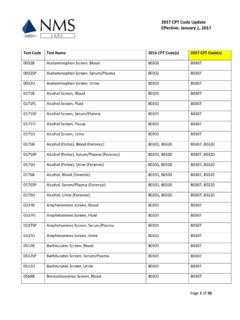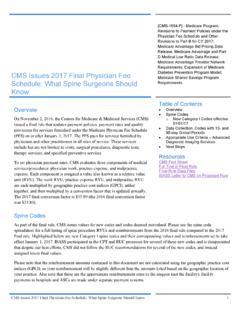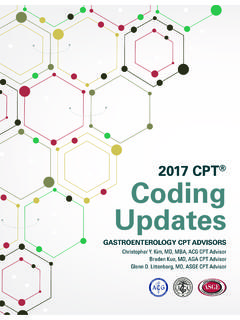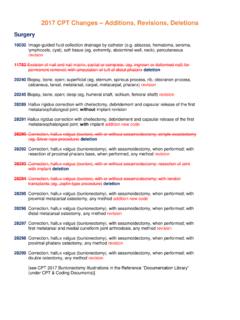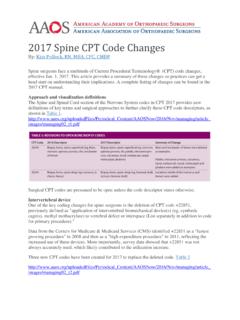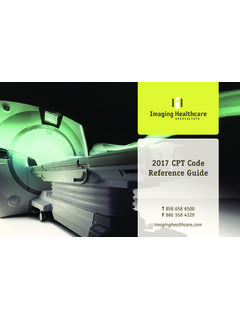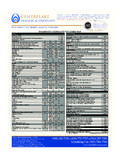Transcription of CPT Coding of Neurologic Procedures for 2017
1 2017 The American Academy of Neurology Institute. CPT Coding OF Neurologic Procedures FOR 2017 Neil A. Busis, MD University of Pittsburgh School of Medicine Pittsburgh, PA Introduction This syllabus reviews the CPT codes for Neurologic Procedures for 2017 . CPT codes are a set of codes, descriptions, and guidelines intended to describe Procedures and services performed by physicians and other health care professionals or entities. Inclusion of a descriptor and associated code number in the CPT Category I code set is based on whether the procedure or service is consistent with contemporary medical practice and is performed by many practitioners in clinical practice in multiple locations.
2 Inclusion or exclusion of a procedure or service does not imply any health insurance coverage or reimbursement policy. Over the last few years there have been major changes in codes for many Neurologic Procedures including EMG and nerve conduction studies, evoked potentials, intraoperative monitoring, chemodenervation, and autonomic function testing. The changes in reimbursement associated with these code changes are outside the scope of this syllabus. Please visit the American Academy of Neurology (AAN) website at < > for up to date information on Coding , billing, and reimbursement for Neurologic services and Procedures , and on the Academy s advocacy efforts to get fair reimbursement for our specialty.
3 CPT codes are updated yearly. For 2017 there are minor changes in some parenthetical notations for codes that are displayed out of numerical order. Previous editions of this syllabus were quite comprehensive, listing in detail many Procedures rarely used by most neurologists. This version focuses on the CPT Category I procedure codes most commonly used by our specialty. The final sections discuss the creation and revision of Neurologic CPT codes, their links to reimbursement, and regulations regarding the physician supervision of diagnostic tests. Relevant print and Internet resources are listed at the end of this syllabus.
4 CPT Category II codes - supplemental tracking codes that can be used for performance measurement - and Category III codes - a set of temporary codes for emerging technology, services and Procedures - are not included. The listed CPT codes and their definitions are derived from Current Procedural Terminology: CPT 2017 published by the American Medical Association (AMA) (CPT only 2016 American Medical Association. All Rights Reserved.). The author developed the comments on the codes in collaboration with AAN staff and members of the AAN Medical Economics and Management Committee. Relationship Between Procedures and Evaluation and Management Services The CPT codes for Neurologic Procedures are not defined to include consultation or other evaluation and management services.
5 When appropriate, therefore, codes for these services and skills may be submitted in addition to the codes for any Neurologic Procedures performed on a given patient on a given date. Who Can Use CPT Codes? When advanced practice nurses and physician assistants are working with physicians, they are considered as working in the exact same specialty and exact same subspecialties as the physician. A physician or other qualified health care professional is an individual who is qualified by education, training, licensure/regulation (when applicable) who performs a professional service within his/her scope of practice and independently reports that professional service.
6 Throughout the CPT code set the use of terms such as physician, qualified health care professional, or individual is not intended to indicate that other entities may not report the service. In selected instances, specific instructions may define a service as limited to professionals or limited to other entities (eg, hospital or home health agency). 2017 The American Academy of Neurology Institute. CPT Resequencing Initiative In an effort to meet the growing demands for available numbers in CPT code sets while adhering to the principles of health information technology, the AMA introduced a resequencing system to integrate new code concepts into existing code families regardless of the availability of sequential numbers.
7 In other words, the numbers assigned to some CPT codes will not necessarily fit into the numerical order of some code families. Resequencing utilizes the content within the code descriptor to determine placement and offers flexibility for code assignment beyond the capability of the traditional numbering convention. The resequencing approach for code placement is based on the principal that codes are deleted and a new number is established when the meaning of the code changes, or when other editorial policies apply (eg, a code conversion from Category III to Category I). Deletions to display related codes together in printed materials are not acceptable criteria for renumbering.
8 Adherence to the traditional numbering convention that inherently forces deletion and remembering would compromise the long-term maintenance and integrity of the CPT codes. Resequencing allows related concepts to be placed in a numerical sequence regardless of the availability of numbers for sequential numerical placement, extending the existence of the current five-digit numbering scheme, improving the growth and flexibility of CPT content, and the use of CPT codes in electronic products. The resequencing initiative applies to codes marked by the # symbol. Results, Testing, Interpretation and Report The Introduction at the beginning of the CPT 2017 manual defines the meaning of report: Results are the technical component of a service.
9 Testing leads to results; results lead to interpretation. Reports are the work product of the interpretation of test results. Certain Procedures or services described in the CPT codebook involve a technical component (eg, tests), which produce results (eg, data, images, slides). For clinical use, some of these results require interpretation. Some CPT descriptors specifically require interpretation and reporting to report that code. Coding by Time The CPT code set contains many codes with a time basis for code selection. The following standards shall apply to time measurement, unless there are code or code-range-specific instructions in guidelines, parenthetical instructions, or code descriptors to the contrary.
10 Time is the face-to-face time with the patient. Phrases such as interpretation and report in the code descriptor are not intended to indicate in all cases that report writing is part of the reported time. A unit of time is attained when the mid-point is passed. For example, an hour is attained when 31 minutes have elapsed (more than midway between zero and sixty minutes). A second hour is attained when a total of 91 minutes have elapsed. When codes are ranked in sequential typical times and the actual time is between two typical times, the code with the typical time closest to the actual time is used.
